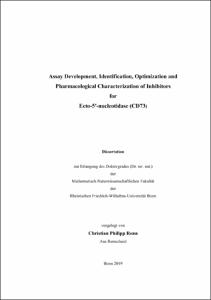Assay Development, Identification, Optimization and Pharmacological Characterization of Inhibitors for Ecto-5′-nucleotidase (CD73)

Assay Development, Identification, Optimization and Pharmacological Characterization of Inhibitors for Ecto-5′-nucleotidase (CD73)

| dc.contributor.advisor | Müller, Christa E. | |
| dc.contributor.advisor | ||
| dc.contributor.author | Renn, Christian Philipp | |
| dc.date.accessioned | 2020-04-27T00:00:27Z | |
| dc.date.available | 2022-11-01T23:00:15Z | |
| dc.date.issued | 29.10.2019 | |
| dc.identifier.uri | https://hdl.handle.net/20.500.11811/8093 | |
| dc.description.abstract | Extracellular ATP acts as a proinflammatory signaling molecule via G protein-coupled P2Y receptors and ATP-gated P2X ion channel receptors. ATP is hydrolyzed by ecto-nucleotidases: In a first step ecto-nucleoside triphosphate diphosphohydrolase1 (NTPDase1, CD39) and nucleotide pyrophosphatase/phosphodiesterase1 (NPP1) convert ATP to AMP, which is then further hydrolyzed by ecto-5’-nucleotidase (CD73) to adenosine and phosphate. Adenosine is a powerful immunosuppressive agent by activating G protein-coupled A2A and A2B adenosine receptors. Many tumors overexpress ecto-nucleotidases, especially CD73 which leads to high amount of adenosine in the tumor microenvironment contributing to tumour immune escape. Thus, inhibitors for CD73 have been proposed as a novel strategy for cancer immunotherapy. In the present study, we aimed to identify and characterize new CD73 inhibitors with high potency and selectivity across species, to support the (patho)physiological investigation of CD73. To this end, we recombinantly expressed human soluble CD73 and additionally produced membrane preparations of the human triple-negative breast cancer cell line MDA-MB-231, which natively expresses large amounts of CD73. We optimized a sensitive radioassay, studied the structure-activity relationships for nucleotide and sulfonamide derivatives and analogs and investigated potential therapeutic antibodies directed against CD73. The most potent small molecule inhibitors showed potency in the low nM range at soluble rat and human, as well as human membrane-bound CD73. Moreover, a radioligand for CD73 with picomolar potency at CD73 was developed. For the identification of new scaffolds, we established an enzyme assay suitable for high-throughput screening based on phosphate detection with malachite green and screened about 6000 compounds of an in-house compound library. We identified, among others, xanthine derivatives representing a new scaffold for CD73 inhibitors. The developed assays, inhibitors and tool compounds for CD73 will help to further investigate the (patho)-physiological roles of CD73 and its potential as a drug target in cancer immunotherapy and other diseases. | en |
| dc.language.iso | eng | |
| dc.rights | In Copyright | |
| dc.rights.uri | http://rightsstatements.org/vocab/InC/1.0/ | |
| dc.subject | Krebsimmuntherapie | |
| dc.subject | Adenosin | |
| dc.subject | Enzym | |
| dc.subject | Hochdurchsatz-Screening | |
| dc.subject | Radioassay | |
| dc.subject | Cancer immunotherapy | |
| dc.subject | Adenosine | |
| dc.subject | Enzyme | |
| dc.subject | High-throughput screening | |
| dc.subject.ddc | 615 Pharmakologie, Therapeutik | |
| dc.title | Assay Development, Identification, Optimization and Pharmacological Characterization of Inhibitors for Ecto-5′-nucleotidase (CD73) | |
| dc.type | Dissertation oder Habilitation | |
| dc.publisher.name | Universitäts- und Landesbibliothek Bonn | |
| dc.publisher.location | Bonn | |
| dc.rights.accessRights | openAccess | |
| dc.identifier.urn | https://nbn-resolving.org/urn:nbn:de:hbz:5-56186 | |
| ulbbn.pubtype | Erstveröffentlichung | |
| ulbbnediss.affiliation.name | Rheinische Friedrich-Wilhelms-Universität Bonn | |
| ulbbnediss.affiliation.location | Bonn | |
| ulbbnediss.thesis.level | Dissertation | |
| ulbbnediss.dissID | 5618 | |
| ulbbnediss.date.accepted | 15.10.2019 | |
| ulbbnediss.institute | Mathematisch-Naturwissenschaftliche Fakultät : Fachgruppe Pharmazie / Pharmazeutisches Institut | |
| ulbbnediss.fakultaet | Mathematisch-Naturwissenschaftliche Fakultät | |
| dc.contributor.coReferee | Schiedel, Anke C. | |
| ulbbnediss.date.embargoEndDate | 01.11.2022 | |
| ulbbnediss.contributor.gnd | 124064650X |
Dateien zu dieser Ressource
Das Dokument erscheint in:
-
E-Dissertationen (4077)




